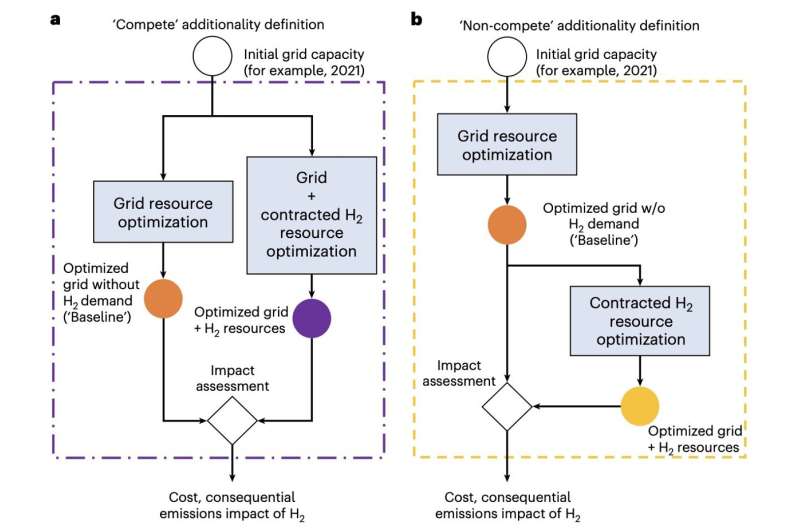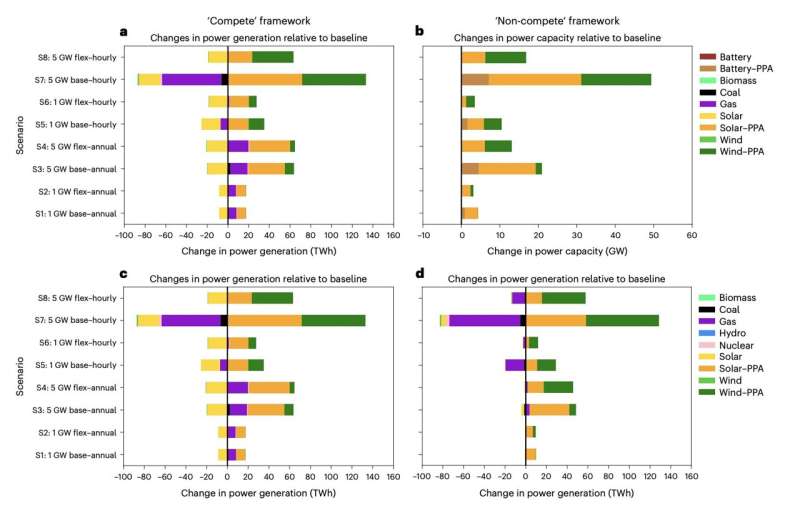January 31, 2024 feature
This article has been reviewed according to Science X's editorial process and policies. Editors have highlighted the following attributes while ensuring the content's credibility:
fact-checked
peer-reviewed publication
trusted source
proofread
Exploring the impact of grid-connected hydrogen production on carbon emissions

Countries worldwide have been introducing new policies aimed at mitigating climate change and reducing carbon emissions. Many of these interventions focus on deploying more sustainable systems to supply electricity on a large scale and introducing new technologies powered by electric power, such as electric vehicles and electrolyzers (i.e., electrically powered devices that can split water into hydrogen and oxygen atoms).
The use of electrolyzers has recently gained particular attention as a way of producing and storing hydrogen gas (H2), which is of vital importance for various applications, ranging from the synthesis of ammonia for fertilizers to the fabrication of fuel cells to power large vehicles or trains.
While electrolyzers can be powered using renewable energy sources, if powered by current electricity grids these devices could potentially lead to even higher carbon emissions than conventional methods of producing H2.
Assessing the impact of grid-connected electrolyzers on decarbonization efforts is thus of utmost importance, particularly in the United States (US) where an emissions-indexed production tax credit (PTC) for those producing H2 was established. This financial incentive gives projects with low lifecycle greenhouse gas emissions a tax credit of up to $3 per kilogram of hydrogen produced.
Researchers at Massachusetts Institute of Technology (MIT) examined how different interpretations of contracted variable renewable energy (VRE) sources (i.e., sources of energy that rely on changing weather conditions, such as solar and wind energy) and energy system policies can affect the costs and emissions of electrolytic hydrogen production.
Their paper, published in Nature Energy, shows that different assumptions about the VRE used to power grid-connected electrolyzers can significantly influence estimations of resulting carbon emissions.
"The literature provides conflicting guidance about the appropriate time-matching requirement between electricity consumption by electrolyzers and contracted variable renewable energy (VRE) for qualifying hydrogen (H2) as 'low carbon,'" Michael A. Giovanniello, Anna N. Cybulsky and their colleagues wrote in their paper. "We show that these findings are highly influenced by different interpretations of additionality."

Giovanniello, Cybulsky and their colleagues carried out their analyses using an energy systems model called DOLPHYN. This model allowed them to estimate the emissions and costs of grid-connected electrolyzers under different hypothetical scenarios or conditions.
The researchers specifically explored the differences between scenarios in which VRE resources helping to meet electricity demands beyond the production of hydrogen compete or do not compete with VRE contracted for H2 production. In addition, they focused on distinct scenarios in which VRE requirements were either hourly or annual.
The results of the team's analyses suggest that these varying interpretations result in different carbon emission estimates. Therefore, approaches to define the time-matching requirements to determine PTC eligibility and assess the actual impact of grid-connected electrolyzers on emissions should take these influencing factors into account.
"Substantially lower consequential emissions are achievable under annual time matching when presuming that VRE for non-H2 electricity demand does not compete with VRE contracted for H2, as opposed to when assuming that all VRE resources are in direct competition," the researchers explained in their paper.
"Further analysis considering four energy system-relevant policies suggests that the latter interpretation of additionality is likely to overestimate the emissions impacts of annual matching and underestimate those of hourly matching."
The results of the analyses carried out by this team of researchers could potentially inform policymaking, particularly the drafting of eligibility requirements for receiving PTC tax credits. In addition, this study could pave the way for further works aimed at modeling the economic and environmental impact of H2 production projects involving electrolyzer deployment.
"We argue for starting with annual time matching in the near term for the attribution of the H2 US production tax credits, where conditions resemble the 'non-compete' framework, followed by phase-in and subsequent phase-out of hourly time-matching requirements as the grid is deeply decarbonized," the researchers wrote.
More information: Michael A. Giovanniello et al, The influence of additionality and time-matching requirements on the emissions from grid-connected hydrogen production, Nature Energy (2024). DOI: 10.1038/s41560-023-01435-0
© 2024 Science X Network















